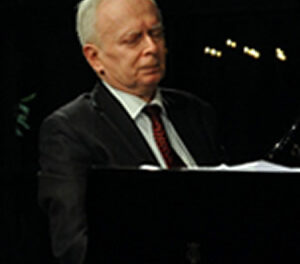In the concert series Sights and Sounds on Sunday (SSS), the Raleigh Chamber Music Guild and the Museum set an ambitious goal: To relate the concert programs by North Carolina musicians and ensembles to the art in the Museum’s collection. Appropriately, they invited the Degas Quartet — violinists James Dickenson and Tamaki Higashi, violist Simon Ertz and cellist Philip von Maltzahn — to present a program titled “Three Portraits of France,” related to French Impressionist paintings. Alas, we find increasingly that the raison d’être behind this series is seldom fulfilled, notwithstanding the generally high quality of the musicians. Sunday’s concert was a case in point.
The Degas Quartet, based in Hickory, is Quartet-in-Residence with the Western Piedmont Symphony, and is a world-traveling ensemble and advocate of contemporary music. The Quartet possess a warm tone, good intonation and an excellent precision in dynamically and rhythmically complex difficult music.
In order to comply with the series’ theme, slides of paintings by Claude Monet and Camille Pissaro were projected on the wall over the musicians’ heads during the concert, presumably to deepen our understanding of the music and how it relates to art. Unfortunately, with the lights on over the performers, it was nearly impossible to see the paintings. But more important, no one explained whether — or how — these paintings relate to the music performed. In fact, we had to sort through the on-line catalogue of the NCMA’s collection to ascertain the titles of the works and, in some cases, the artist. Now, we can’t expect every musician who comes to call to be able to provide a disquisition on comparative arts, but by this time — the series has been around for a number of years — it behooves the Raleigh Chamber Music Guild to find someone who can.
Now to the music. Following a healthy trend, the program featured music from the 20th and 21st centuries. It opened with String Quartet No.4, Op.46 by Darius Milhaud (1892-1974), composed in 1918 while the young composer was attaché in charge of propaganda at the French Embassy in Brazil. The first movement, Vif (fast), has the character of a French folksong seen through Picasso’s eyes. The second movement, Funèbre, consists of rhythmic and thematic fragments which were difficult to interpret on our first hearing. The rhythmic finale, Tres Animé (very lively), introduces a hint of South-American rhythms. The Degas members played with a light-hearted energy befitting a light-weight opener.
Laura Kaminsky (b.1956), currently director of the Conservatory of Music at Purchase College/State University of New York, is an American composer primarily of chamber and vocal works. She composed the five-movement, 25-minute Monotypes last year specifically for the Degas Quartet. The title refers to monotypes — the simplest form of printmaking — by Edgar Degas that influenced Kaminsky’s composition. The music was anything but monotype and, without seeing the prints, it was difficult to figure out the relationship between music and image. Instead, several paintings by Pissaro were substituted, which left Dickenson somewhat at a loss as to what to say about them in relation to the Quartet. We think that for future performances, the Degas should bring with them professionally made slides of the inspirational monotypes or perhaps offer a sheet with reproductions in the concert program.
Kaminsky’s Quartet is a long and difficult work, one of those pieces that requires multiple hearings before making judgments. The same may apply to the players, who remarked after the concert that this was only the second time they had performed the piece in public. Although they appeared to have all the notes, Dickenson kept the group in line with sniffing signals — usually during rests. The Degas is a quartet that is definitely going places, and this sniffing thing is probably a habit from rehearsals, but it’s one that Dickenson needs to replace with something more subtle or at least less audible.
The program ended with Maurice Ravel’s Quartet in F. It may be 100 years old, but it is still fresh and exciting, and the Degas’ performance made it even more so. The second movement with its wild pizzicato was especially well played.











